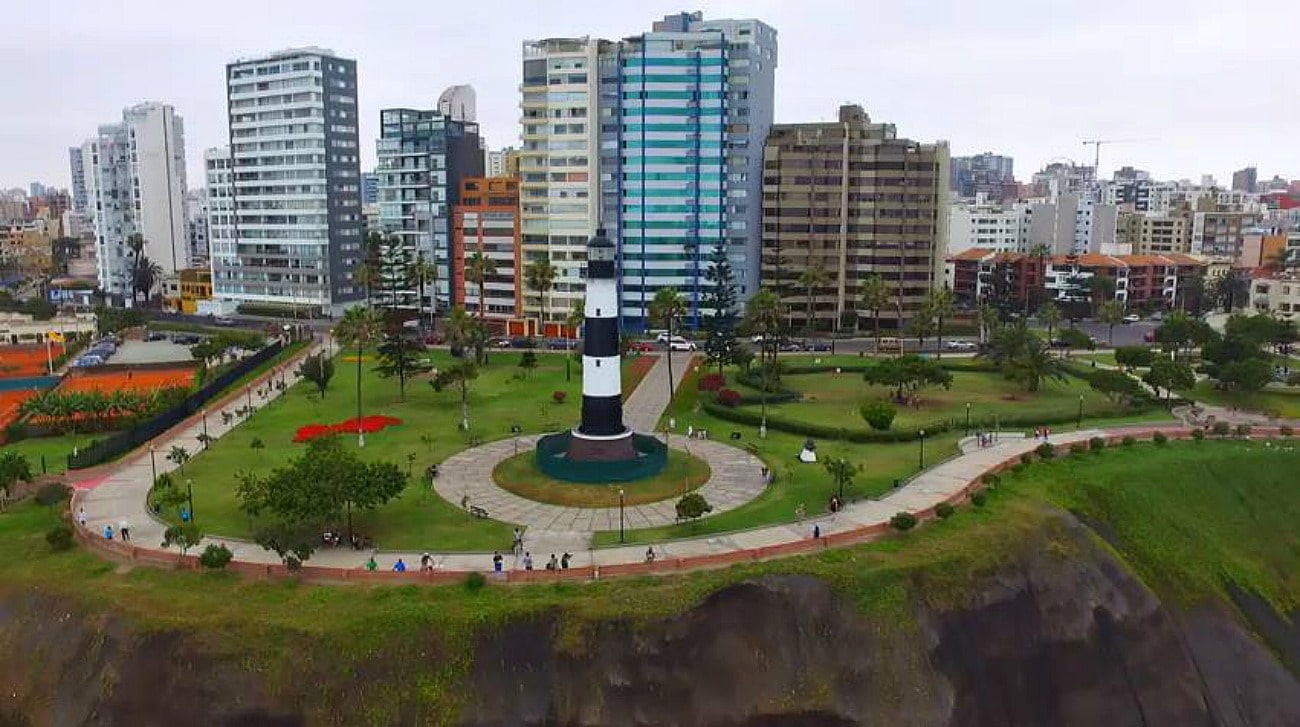Our travel may be temporarily interrupted, but we can still dream and plan. We’re here to bring you travel inspiration for the trips you’ll take when life returns to normal. – TravelSquire Editors
TravelSquire named Machu Pichu and Cusco, Peru to our Top 28 Destinations for 2020 for good reason. The blend of natural beauty and cultural importance make both must-see places; but another Peruvian destination is always on our radar. That is Lima, a city with history, a world-renowned dining scene, stunning architecture and enough shopping and culture to keep you busy for weeks.
Lima served as the capital of Spain’s South American empire for centuries, influencing the architecture – the buildings around Plaza de Armas for example – the food and the culture. But the city’s appeal goes beyond the Spanish influence into territory that’s uniquely Peruvian, exclusively Limeño, and universally appealing. Surfers come to Lima to explore the city’s storied breaks. Art lovers come for the museums. Gastronomes come for the cuisine, especially the ceviche. Add to these the pre-Incan ruins within the city and all the shopping and nightlife, and you’ve got a destination that’s primed for exploring.
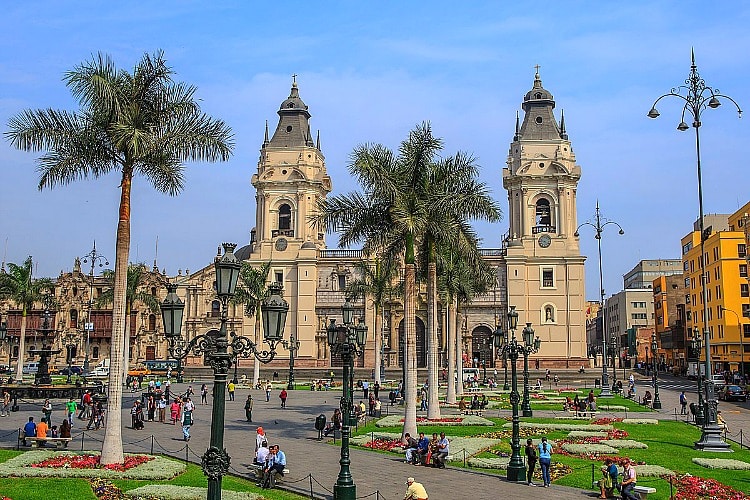
Museums and Culture
Plaza de Armas, also called Plaza Mayor, is where Spanish Conquistador Francisco Pizarro founded Lima in 1532. As the city’s main square, it’s a touristy spot, but for good reason: it’s gorgeous. Lawns and flower gardens, a hugging paved square, and buildings on all sides with lemon-yellow facades are what make it a must-see. The other is the architecture. The Spanish influence is evident in the Palacio de Gobierno (Presidential Palace), but the Cathedral of Lima, which was destroyed by earthquakes and rebuilt several times, shows Baroque, Neoclassical and Gothic touches on the exterior. A look inside at the soaring ceiling and gold-plated altar will leave you awestruck, as will the hand-carved balconies on the Archbishop’s palace next door.
At the Monastery of San Francisco, tours of the catacombs, the library and the cloisters give you a sense of the city’s Moorish background along with frescoes, mosaics and carvings from the late 17th century. A visit to the Museo de Arte de Lima (the Lima Art Museum), also called MALi, will give you a taste of pre-Columbian pottery, contemporary art and everything in between. For a deeper dive into pottery and relics, look no further than Museo Larco, where you’ll find exhibits on the how and why of human sacrifice in cultures across South and Central America as well as an impressive collection of earthenware artifacts.
Four festivals and holidays draw big crowds throughout the year. Celebrate the founding of Lima on January 18 with parades, concerts, and parties throughout the city. On July 28, Peru’s Independence Day is done right in the nation’s capital. September’s Mistura Food Festival is a walking tour of Peruvian cuisine with street carts to the most exclusive restaurants getting in on the action. Finally, an odd religious festival happens one week in October when the Señor de los Milagros, a fresco believed to have miraculous healing powers, is paraded through the streets.
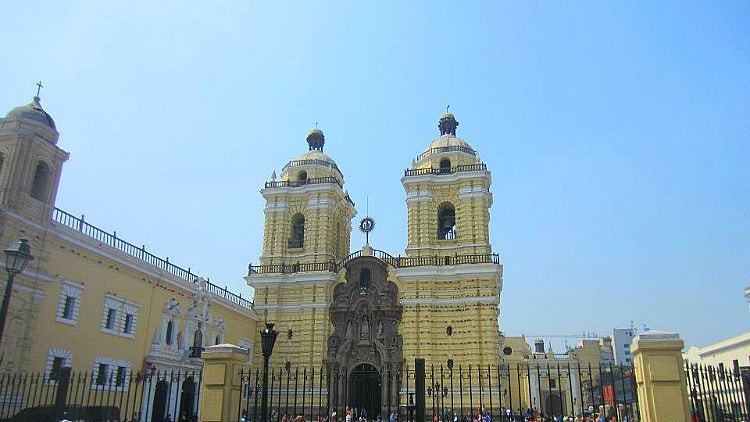
Ceviche
Ceviche – an elegant dish of raw fish cured in fresh citrus juice – was born in Peru, and there’s no better place to try it than Lima. Why? Because it’s often said that ceviche was perfected here. With the Pacific Ocean supplying an endless supply of fresh fish and countless cevicherias along the docks, we’re not surprised that Lima is the place to dive in for some. Served with toasted tortillas or chifles – thin slices of fried plantain – ceviche is the perfect bite of Peru whether you’re at home wishing you were there or overlooking the Pacific with a Pisco Sour in hand.
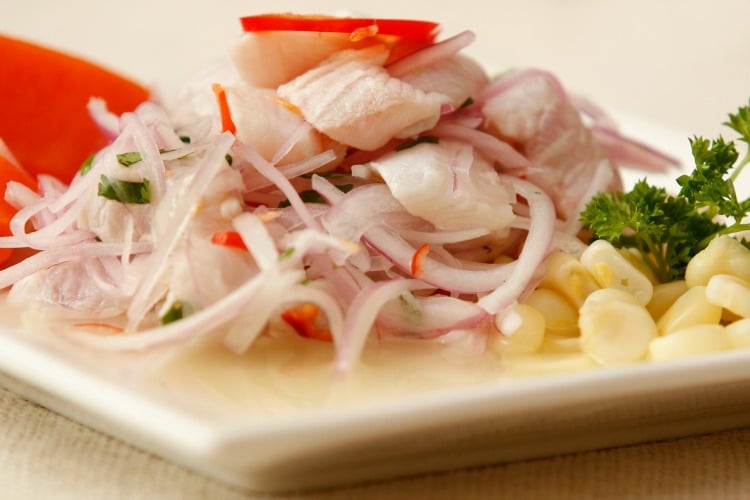
Cuisine
Lima has become synonymous with haute cuisine in South America, and the influence of the native peoples, especially their foods, is on constant display. Chinese traders, African slaves, Spanish rulers and visitors from around the world have shaped the city’s food scene. Barrio Chino, Lima’s version of Chinatown, is home to an enormous Chinese-Peruvian population and eating chifa – Chinese-Peruvian cuisine- is a must whether it’s in traditional Chinese dishes with a Peruvian spin or in hybrids like Lomo Saltado – loin steak cooked in a wok with onions, peppers and soy sauce and served with both rice and French fries – Tallarin Saltado – think chow mein with a Peruvian spin – or Arroz Chaufa – fried rice that’s a cousin to what we know.
Explore beyond chifa, though. Try the ceviche (it’s so good I have to mention it again), which is completely different depending on the fish, the seasoning and the preparation. Dig in to cuy – that’s guinea pig – from a street vendor (if you’re brave) or from a restaurant where you can order a bit to share (so everyone gets to taste).
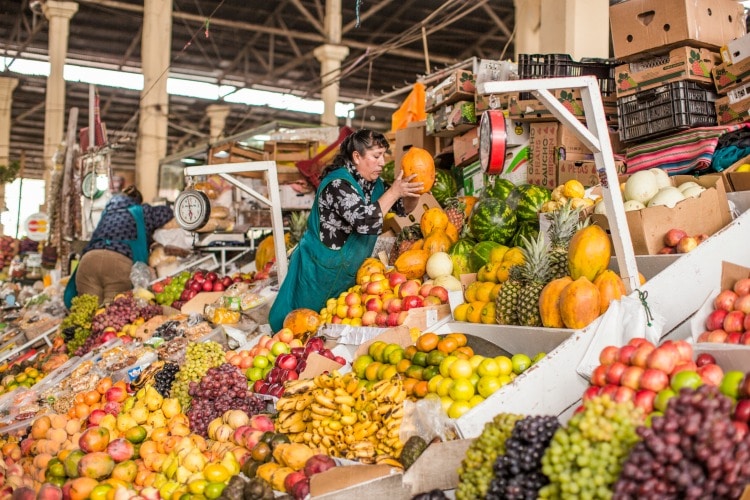
Markets
Peruvian cuisine is centered around fresh ingredients and there’s no better way to learn about them than to spend a morning in the markets. At Terminal Pesquero de Villa Maria del Trifuno, the largest fish market, you’ll find hundreds of stalls selling more fish than you can imagine (go early, it closes shortly after 8 a.m.) and outside you’ll find a few selling fresh ceviche (see, I couldn’t help but mention it a third time). Mercado de Surquillo and Calle Narcisco de La Colina draw foodies from across the city. Here, some stalls sell produce, meat, and fish and others serve up dishes you’ll dream about; but don’t get too hasty to sit down and eat, take time to explore the produce for sale. Fruits like the tiny, ultra-tart limes and exotic specimens from the Amazon basin overflow from baskets (you may be able to sample one if you ask), and there are numerous bins bursting with potatoes (more than 3,000 kinds in Peru).
For souvenir shoppers, Feria Artesanal offers up Peruvian goods from alpaca sweaters and take-home culinary treats to t-shirts and magnets to fine jewelry, elegant textiles, and ornate carvings. The Inca Market, which is packed with bright and colorful scarves, shawls, pots and plates, jewelry and more, is another must-shop market when you want something to remember your trip.
And you can’t overlook Mercado Central for a taste of what it’s like to live and shop in Lima. This enormous building is like a supermarket on steroids. Countless stalls sell everything you can imagine from meat, fish and produce to clothes, shoes, CDs, DVDs and video games to cookware, art and more. At Mercado Central and at any other market, don’t be afraid to haggle as dickering over the price is part of Peruvian culture.
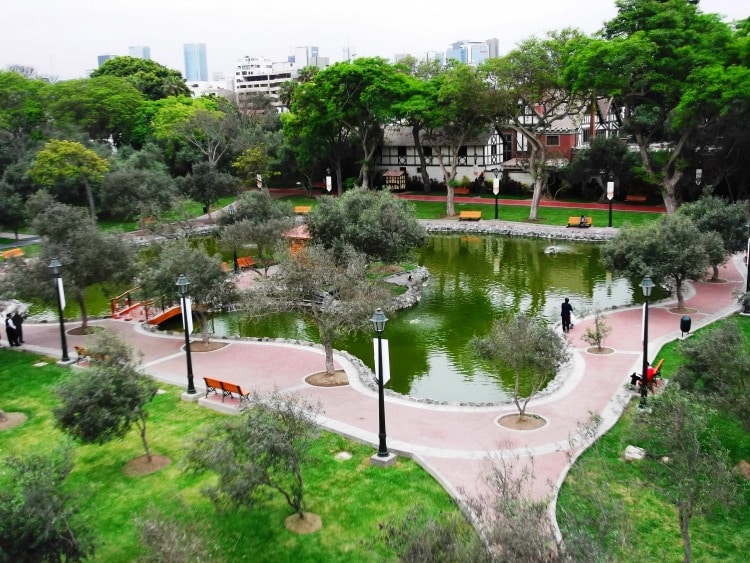
Parks & Recreation
Bosque el Olivar, the Olive Grove Forest, dates to the city’s founding and is, as promised, loaded with olive trees, more than 1,600 of them to be exact. This park is an oasis, a place where you can recharge while surrounded by nature. The twisted trees, some bearing scars from the War for Independence, are a lovely sight and the park is ideal for a picnic.
At El Parque del Amor (Love Park) you’ll find one of the city’s famous pieces of statuary, El Beso (The Kiss), depicting lovers locked at the lips. Look around and you’ll find plenty of romantics there too, either arm in arm – or kissing like the statue – while overlooking the Pacific. This is one of several parks overlooking the ocean with the Malécon (Boardwalk) running alongside it. Thousands of jogging, cycling, strolling Limeños ply the six-mile route along the picturesque cliff’s edge. Several bike rental companies are near if you want to get in on the action.
From the cliffs you’ll see two sights: surfers on the waves below and paragliders in the skies above. With the help of the constant wind off the Pacific Ocean, paragliders launch themselves into the air and drift along, simultaneously taking in the sights and becoming one. Surfers, who come to Lima for the consistent breaks, visit Punta Roquitas with their short boards and Playa Wakiki with their longboards.
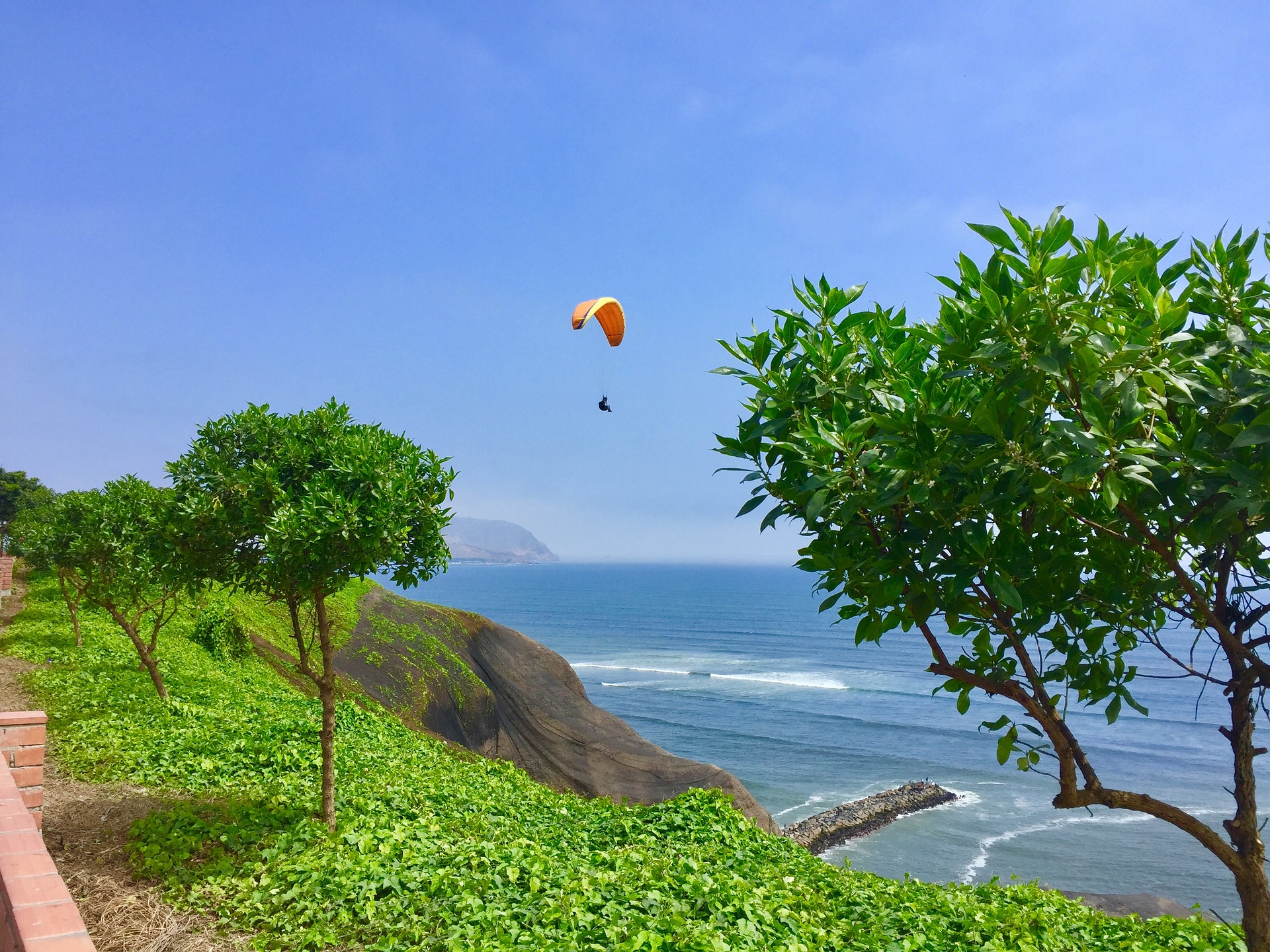
Nightlife
Limeños like to get started late in the evening so if you’re looking to disco hop, don’t head out until after 11 pm. But when the party does get started, it usually goes all night (or close enough). The best bars and dance clubs are in the Miraflores neighborhood, in Barranco and near Plaza de Armas. Cocktail culture is alive and well here, with plenty of Pisco Sours to be had and many other drinks using Pisco, Peru’s powerful spirit, as a base. Just know that bartenders here aren’t one-note; they’ll shake up something different that’ll delight your taste buds and loosen up your hips a little, making all that dancing a little easier.
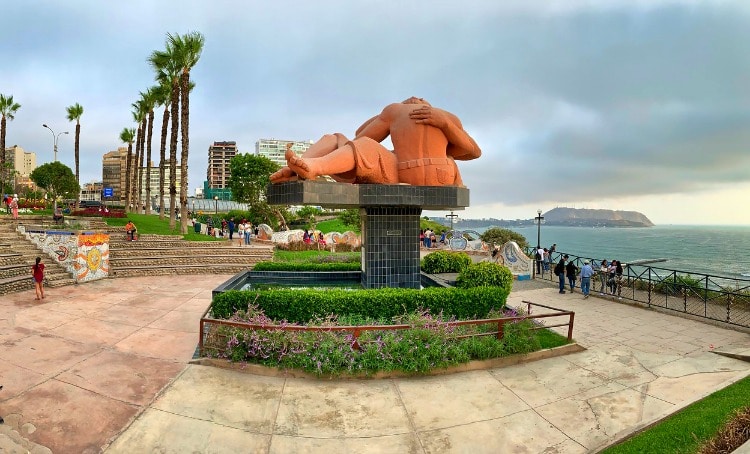
[alert type=white]
The country code for Lima is 51.
Where to Stay:
Hyatt Centric Lima – A refreshing take on hospitality with original art installations and dynamic furnishings is front and center here at Lima’s numero uno place to stay, see and be seen in the tony San Isidro neighborhood. The rooftop pool and Celeste Bar & Lounge are both dazzling and the onsite Bistro Limeño serves a delicious breakfast every day. Av. Jorge Basadre #367, Lima, +51 611 1234; www.hyatt.com
Country Club Hotel – A grand hotel needs grand guests. The Country Club’s got them. Go with deep pockets and splurge for a Pisco Sour at The English Bar. Avenida los Eucaliptos 590, San Isidro, Lima, +51 611 9000; www.travelsquire.com/country-club-lima-hotel
Hotel B – To die for art-filled interiors in a restored mansion with an exclusive restaurant helmed by Franco Hortado who specializes in contemporary Peruvian cuisine. A stay here is an intimate and romantic experience. Saenz Pena 204, Barranco, Lima, +51 206 0800; http://www.hotelb.pe
Where to Eat:
The Best of Lima Culinary www.travelsquire.com/culinary-highlights-of-lima
Astrid & Gaston – Av. Paz Soldán 290, San Isidro, Lima; www.en.astridygaston.com
Central – Av. Pedro de Osma 301, Barranco, Lima; www.centralrestaurante.com.pe
Mayo – Av. Pedro de Osma 301, Barranco, Lima; www.mayobar.com
Amaz – Av. La Paz 1079, Miraflores, Lima; www.amaz.com.pe
Maido – Calle San Martin 399, Miraflores, Lima; www.maido.pe
Huaca Pullcana – Calle General Borgoño, Jiron Pedro Villalobos, Lima; www.resthuacapucllana.com
La Gastronoma – Calle Libertad 439, Miraflores, Lima
*no website, only Facebook – www.facebook.com/lagastronomaperu
La Niña – Francisco de Paula Camino 299, Miraflores, Lima; www.lanina.pe
Where to Drink:
Carnaval Bar – Don’t miss this temple to cocktails, if only to try The Carnaval, its signature drink. Av. Pardo y Aliaga 662, San Isidro, +51 986 787 755; www.carnavalbar.com
What to See & Do:
MATE Mario Testino Museum – Fashion and celebrity photo-journalist Mario Testino’s homage to his lengthy and well-documented career including his famous photos of Princess Di for Vanity Fair. The Peruvian photographer has also snapped haunting images of the indigenous people from the rural communities around Cusco in traditional dress. Av. Pedro de Osma 409, Barranco, +51 200 5400; www.mariotestino.com
[/alert]

